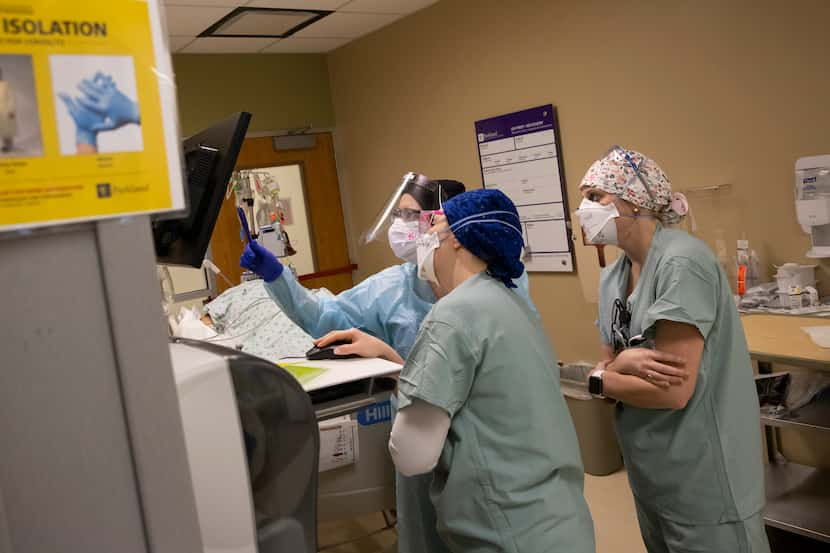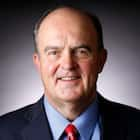AUSTIN — The state is trying to wind down an expensive, federally paid program of hiring nurses and other health care professionals to keep its hospitals from buckling under staffing pressures and burnout caused by the COVID-19 pandemic.
But the plan could be upended by any spike in COVID-19 cases prompted by gatherings over the holidays. Already, the state decided to keep up surge staffing at hospitals in El Paso and the Panhandle because of recent outbreaks.
After three huge waves of hospitalizations — in each of the past two summers and the big daddy of them all, last December and January — the state has spent nearly $7 billion of federal COVID-19 money for temporary nurses, respiratory therapists and some doctors to maintain operations at hospitals and “alternate care sites.”
The state set up the alternate care sites, mostly at nursing homes and convention centers, to free up hospital beds for coronavirus patients.
The decision to begin ramping down the “medical surge staffing” could be premature. Some public health officials worry that many Texans will mingle indoors and maskless during the upcoming holidays, among them unvaccinated state residents, creating a spike in both seasonal flu and COVID-19 that strains hospitals to capacity.
The Texas Department of State Health Services has told the three vendors who provide the hospitals with temporary caregivers that it plans to stop doing that in most parts of the state over the next month or so, said spokesman Chris Van Deusen.
“Of course, we’re always flexible about that,” he said. “If the situation changes, we’ll change the direction we’re headed.”
Critics of Gov. Greg Abbott’s management of the public health crisis say he’s used hospital staffing support when he should have used a full range of mitigation measures that are far less expensive, such as mask and vaccine mandates.
While the staffing expense is covered 100% by the federal government, the extravagant spending distorted the marketplace for nursing labor, which was already in short supply, said Rep. Donna Howard, an Austin Democrat and retired nurse who has studied the state’s response closely.
‘Burden on the hospitals’
Early in the pandemic, Abbott ordered hospitals to postpone elective surgeries, which choked off vital revenue streams, Howard said. But the Republican governor only hesitatingly embraced a statewide masking and distancing order, which he fully lifted in early March, she noted.
More recently, Abbott has stressed state provision — again, thanks to Uncle Sam — of COVID-19 treatments and infusion centers, where infected patients receive monoclonal antibodies that reduce the severity of symptoms.
“Those are great,” Howard said. “But again, though, rather than trying to do things to prevent it from happening in the first place, the interventions have been after the fact. And it’s really been a burden on the hospitals.”
Abbott spokeswoman Renae Eze, noting that nearly 36 million shots have been administered to Texans, said Abbott has launched “innovative strategies” to combat the pandemic. She cited mobile vaccine clinics and a “Save Our Seniors” program he announced in March. Under the program, modeled on one in Corpus Christi given statewide attention by The Dallas Morning News, local first responders and other volunteers take shots to homebound seniors or set up central drive-through vaccine clinics.
“Governor Abbott has prioritized protecting the safety of Texans from COVID while also safeguarding their livelihoods and personal freedom,” Eze said in a written statement.
Abbott continues to work closely with state Health Services Commissioner John Hellerstedt and Emergency Management Chief Nim Kidd “to get shots in arms and provide support to communities across the state,” she said.
“While the vaccine has proven effective at reducing the severity of COVID cases and slowing the spread of COVID, Governor Abbott also recognizes the right of Texans to refuse the shot, especially those who have acquired immunity, have health conditions, or other reasons to not take the shot.”
Many Texans, though, are still resistant to the shot. Only 59% of Texans age 5 or older have been fully vaccinated against COVID-19.
Flu prospects
So far this flu season, Texans haven’t been catching influenza at an alarming rate. Of the nearly 39,000 who’ve been tested since early October, just 0.35% tested positive. At the peak of the 2018-19 flu season, in February 2019, about one-quarter of specimens tested positive for flu, noted epidemiologist Diana Cervantes of the University of North Texas Health Science Center at Fort Worth.
Still, on Wednesday, the federal Centers for Disease Control and Prevention issued an alert warning of a recent increase in flu viruses detected in recent weeks, especially among young adults. The federal agency said it “also is aware of influenza outbreaks in colleges and universities in several states.”
Flu seasons in which the particular strain noticed in the recent uptick — A(H3N2) — is predominant “were associated with more hospitalizations and deaths in persons aged 65 years and older,” the alert said.
The CDC urged all Americans 6 months and older — if they haven’t already, and many haven’t — to get flu shots.
UNT’s Cervantes explained public health officials’ concern.
“As the COVID vaccine has become available, there are many fewer restrictions and prevention measures directed at COVID prevention such as mask usage, physical distancing this year — so we may likely see a more active flu season compared to last year,” she said.
She continued, “There is a possibility that due to the holidays and increased travel and general contact with others, we could see an increase in COVID cases and flu cases jointly, and unfortunately there are always severe cases of both that can require hospitalization leading to dual stresses on our health care system.”
With COVID-19 vaccine widely available and “no new variant of concern” at this point, “I am hopeful we will not see a spike of COVID like we experienced last winter,” Cervantes said.
The surge staffing began in July 2020 with just more than 3,500 visiting health care workers helping Texas hospitals. Peak deployment came after last winter’s surge of cases, with almost 14,000 temporary nurses and other workers used during one week in early February. Last summer, the numbers dwindled. From mid-May to mid-August, no surge staffing was needed.
But then deployments kicked back up with the spike of cases caused by the delta variant. By early October, the department’s three private vendors were supplying nearly 7,800 health care professionals a week. As of Nov. 17, that had dropped to 3,176.
A demobilization ‘pause’
In recent weeks, the department told its three vendors supplying the nurses and other front-line workers — San Antonio-based nonprofit BCFS Health and Human Services, San Antonio-based Angel Staffing Inc. and Columbia, Md.-based Maxim Healthcare Group — that it planned to stop all hospital support in early December.
A flare-up of positive cases in El Paso and the Panhandle has forced the department to keep providing the surge staffing to those two regions, even as it hopes to be able to stop providing nurses and therapists to hospitals in most of the state, said Van Deusen, the state health department spokesman.
“We’ve paused sort of demobilizing staff out in El Paso, for example, because they’ve seen things really start to go up more,” he said. “But yes, that’s been the idea,” to end the program as more Texans are vaccinated and severe cases of the disease taper off.
On Tuesday, the hospital regions where coronavirus patients are taking up the highest percentage of available beds were El Paso (13.3%), Amarillo (11.8%) and Lubbock (9.9%), according to the department’s coronavirus dashboard. Of the four major metros, Dallas had the highest share (4.9%) of hospital beds devoted to COVID-19 patients. There were 768 people with COVID-19 hospitalized in the Dallas trauma service area’s hospitals. Of those, 94 had been admitted in the previous 24 hours.
From just over a year ago, Dallas has zoomed to account for 28% of the surge staffing statewide, from below 10%. South Texas, which in October 2020 drew 35% of the temporary workers helping Texas hospitals, now is using only 11%. As a share of the statewide deployment, Houston has tapered off (to 21% of the total, from 25% a year earlier), while Austin and Central Texas account for nearly 10% of the statewide staffing help, up from about 1% a year earlier.
President Joe Biden recently said that 100% reimbursement of states’ coronavirus-related response efforts, such as the hospital staffing, would continue through April 1.
Van Deusen said that leaving aside considerations about federal reimbursements, the need for the surge staffing has diminished.
Hospitalizations for COVID-19 in Texas have decreased dramatically from the delta variant-driven spike of confirmed cases in late summer. From nearly 14,000 in late August and early September, hospitalized patients have fallen to under 2,700 as of Tuesday.
“We had started ramping down earlier this month, with the idea that it would take probably four to six weeks to do that,” Van Deusen said.
‘Worth it to them’
Some of the health care workers, such as nurses, have commanded high prices to come work at Texas hospitals.
State Rep. Howard said at one point, she was told by the state health department that nurses cost the state $100 to $125 an hour. She said she didn’t know if that was the amount being paid to the vendor or the nurses. The online job site Indeed shows the average registered nurse in Texas commanding about $36 an hour, she noted.
Department officials and vendors have declined to discuss wages paid to the temporary hospital workers.
“You had nurses who left their jobs to become traveling nurses because they could make a heck of a lot more money,” said Howard, who said she’s heard from one of her staff members an anecdote about one who gambled on treating COVID-19 patients in order to get a piece of the American dream: a house.
“They knew that it was going to be short term, but it was worth it to them to leave where they were and go wherever they needed to be for the fairly short period of time and bring in an exorbitant salary,” Howard recounted.
“It allowed them to actually get a mortgage. That was out of sight for them before. They are now able to buy a house because of this, which is great for them. But the distortion in the market is that those very people who are leaving, now, the hospitals are having to find ways to increase what they pay in order to retain their nurses. They’re doing bonuses, they’re doing premium pay, they’re doing whatever they can do, to try to keep the nurses that they have.”
By far the biggest chunk of the nearly $6.9 billion spent since July 2020 has gone to BCFS — $5.3 billion, or 77%.
The state also processed invoices from Angel Staffing for $1.14 billion (17% of the total) and from Maxim, the former Medcall Medical Staffing, for $455 million (6%). Angel and Maxim are privately held, for-profit companies.
As of Nov. 15, BCFS had 1,945 medical personnel working in 235 Texas hospitals, said BCFS spokeswoman Evy Ramos. Except for about 300 respiratory therapists, they were all nurses, she said. None was a physician.
Of the $6.88 billion spent, just under $2.4 million was state funds, according to a spreadsheet of vendor payments obtained by The Dallas Morning News.
“The funds obligated are federal, FEMA and CARES Act dollars,” said state health department spokesman Doug Loveday, referring to the Federal Emergency Management Agency and the Coronavirus Aid, Relief and Economic Security Act of 2020.
An additional $8.7 million of the money went to alternate care sites.
None of the money spent yet has come from the American Rescue Plan Act passed in March, though state lawmakers last month approved spending up to $2 billion of that legislation’s money on hospital surge staffing, COVID-19 therapeutics and infusion centers.


/cloudfront-us-east-1.images.arcpublishing.com/dmn/XGW2K7N7CFCSFBQVJSCAYJXNOE.jpg)
/cloudfront-us-east-1.images.arcpublishing.com/dmn/R4ZQGZRVQVGNC4NQXEUW6EDMDQ.jpg)
/cloudfront-us-east-1.images.arcpublishing.com/dmn/3PTVVLIGX5AHNA3N7PGQXEE7HI.png)
:no_upscale()/cloudfront-us-east-1.images.arcpublishing.com/dmn/E2N3VYKOBRHBNPQ3LZTAB2FH4Y.jpg)
/cloudfront-us-east-1.images.arcpublishing.com/dmn/ZRQQFJWBDBFSVKWA7JTUJMHE6E.jpg)